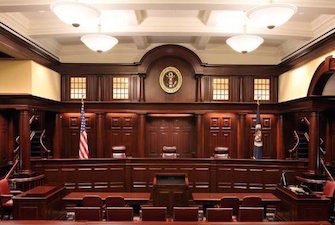“The CAFC rejected Network-1’s argument that even if the court were to revise the district court’s decision on estoppel, the CAFC ‘might affirm the JMOL on alternative grounds relating to substantive validity arguments in Network-1’s JMOL motion that the district court did not reach.’”
 On November 20, the United States Court of Appeals for the Federal Circuit (CAFC) issued a modified opinion following a petition for panel rehearing filed by Network-1. The petition for panel rehearing came after the CAFC affirmed-in-part and reversed-in-part a district court’s claim construction and remanded the case to the district court on September 24, 2020, in Network-1 Technologies, Inc. v. Hewlett-Packard Company. In the revised opinion, the CAFC said that it would not consider Network-1’s alternative grounds for granting a judgment as a matter of law (JMOL) on validity nor its new trial motion in the first instance.
On November 20, the United States Court of Appeals for the Federal Circuit (CAFC) issued a modified opinion following a petition for panel rehearing filed by Network-1. The petition for panel rehearing came after the CAFC affirmed-in-part and reversed-in-part a district court’s claim construction and remanded the case to the district court on September 24, 2020, in Network-1 Technologies, Inc. v. Hewlett-Packard Company. In the revised opinion, the CAFC said that it would not consider Network-1’s alternative grounds for granting a judgment as a matter of law (JMOL) on validity nor its new trial motion in the first instance.
District Court and IPR Proceedings
The case arose when Network-1 filed an infringement suit in the district court against Hewlett-Packard (HP) for allegedly infringing U.S. Patent No. 6,218,930 (the ’930 patent), which was titled “Apparatus and Method for Remotely Powering Access Equipment over a 10/100 Switched Ethernet Network.” A jury determined that HP did not infringe any of the asserted claims and that the asserted claims were invalid. Network-1 moved for judgment as a matter of law (JMOL) on validity and requested a new trial on infringement and validity. Parallel with the district court proceedings, the ’930 patent was reexamined twice before the U.S. Patent and Trademark Office’s Patent Trial and Appeal Board (PTAB) and an IPR was instituted following the filing of a petition by another defendant, Avaya. The district court denied Network-1’s motion for a new trial on infringement, but granted its request for a judgment as a matter of law (JMOL) on validity, noting that “because of HP’s joinder to the Avaya IPR, HP should have been estopped under 35 U.S.C. § 315(e) from raising the remaining obviousness challenges, which it determined ‘reasonably could have been raised’ in the Avaya IPR.” The district court did not conditionally rule on the motion for a new trial with respect to validity.
Statutory Estoppel
On appeal, the CAFC concluded, in part, that “the district court erroneously granted JMOL with respect to the ’930 patent’s validity based on its determination that HP was estopped under 35 U.S.C. § 315(e) from presenting obviousness challenges as a consequence of its joinder to the Avaya IPR.” Noting that joinder and any resulting joinder are controlled by the America Invents Act (AIA), the CAFC cited Facebook, Inc. v. Windy City Innovations in stating that “the joinder provision does not permit a joining party to bring into the proceeding new grounds that were not already instituted.”
In the revised opinion, the CAFC rejected Network-1’s argument that even if the CAFC were to revise the district court’s decision on estoppel, the CAFC “might affirm the JMOL on alternative grounds relating to substantive validity arguments in Network-1’s JMOL motion that the district court did not reach.” The CAFC acknowledged Network-1’s argument that there was an outstanding new-trial motion that must be ruled upon and agreed with Network-1 that the district court failed to rule on Network-1’s motion for a new trial on validity even though it was required to do so. However, the CAFC declined to consider Network-1’s alternative grounds for JMOL nor its new trial motion in the first instance. Thus, the CAFC remanded to the district court for further proceedings, including “ruling in the first instance on Network-1’s entitlement to JMOL (notwithstanding [the CAFC’s] holding on estoppel) and its new-trial motion.”
The remainder of the revised opinion mirrored the September 24 opinion and the CAFC ultimately affirmed-in-part, reversed-in-part, vacated, and remanded the case to the district court for further proceedings consistent with the revised opinion.

![[IPWatchdog Logo]](https://ipwatchdog.com/wp-content/themes/IPWatchdog%20-%202023/assets/images/temp/logo-small@2x.png)

![[Advertisement]](https://ipwatchdog.com/wp-content/uploads/2024/04/UnitedLex-May-2-2024-sidebar-700x500-1.jpg)
![[Advertisement]](https://ipwatchdog.com/wp-content/uploads/2024/05/Quartz-IP-May-9-2024-sidebar-700x500-1.jpg)
![[Advertisement]](https://ipwatchdog.com/wp-content/uploads/2024/04/Patent-Litigation-Masters-2024-sidebar-700x500-1.jpg)

![[Advertisement]](https://ipwatchdog.com/wp-content/uploads/2021/12/WEBINAR-336-x-280-px.png)
![[Advertisement]](https://ipwatchdog.com/wp-content/uploads/2021/12/2021-Patent-Practice-on-Demand-recorded-Feb-2021-336-x-280.jpg)
![[Advertisement]](https://ipwatchdog.com/wp-content/uploads/2021/12/Ad-4-The-Invent-Patent-System™.png)







Join the Discussion
One comment so far.
Ron Abramson
November 26, 2020 10:30 amGood article but it took re-reading to appreciate what it was saying about the scope of estoppel stemming from IPR joinder – that the estoppel is limited because the issues that could have been be raised by the joining party were limited.